Sustainable Tourism in Kenya: Issues and Solutions
VerifiedAdded on 2020/12/28
|9
|2421
|441
Report
AI Summary
This report provides a comprehensive overview of sustainable tourism in Kenya. It begins by defining sustainability and sustainable tourism, highlighting their importance. The report then explores the three pillars of sustainability: environmental, socio-cultural, and economic, emphasizing their roles in the Kenyan context. The main body of the report delves into the specific environmental, economic, and social issues affecting sustainable tourism in Kenya, such as pollution, deforestation, inadequate funding, and cultural impacts. For each issue, the report presents potential solutions, including government initiatives like green economy assessments, community conservancies, and global partnerships. The report concludes by summarizing the key findings and emphasizing the importance of sustainable practices for the long-term success of Kenya's tourism industry, which is a significant contributor to the country's economy. The report stresses the necessity of balancing economic growth with environmental protection and social well-being.

Sustainable Tourism in Kenya
Paraphrase This Document
Need a fresh take? Get an instant paraphrase of this document with our AI Paraphraser
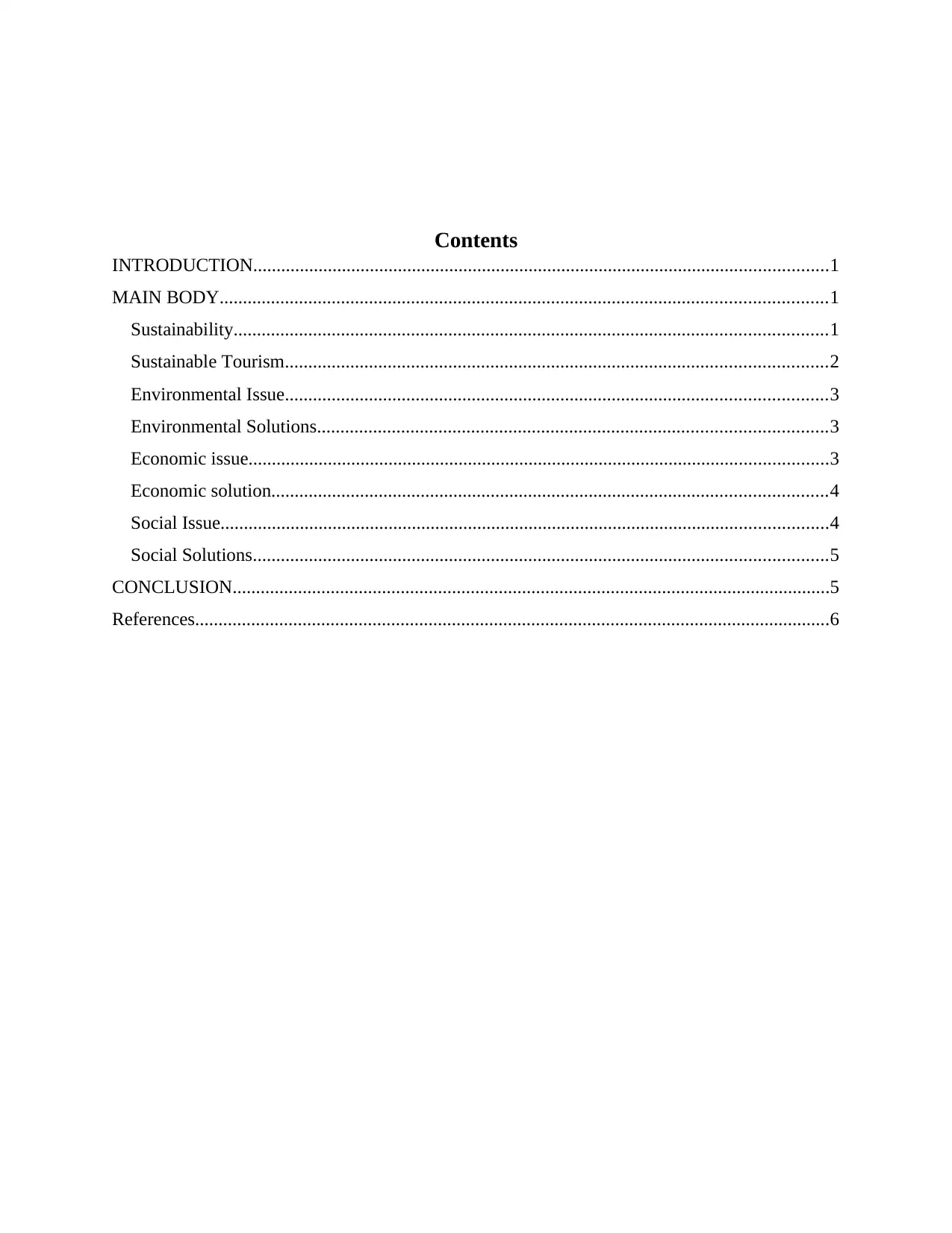
Contents
INTRODUCTION...........................................................................................................................1
MAIN BODY..................................................................................................................................1
Sustainability...............................................................................................................................1
Sustainable Tourism....................................................................................................................2
Environmental Issue....................................................................................................................3
Environmental Solutions.............................................................................................................3
Economic issue............................................................................................................................3
Economic solution.......................................................................................................................4
Social Issue..................................................................................................................................4
Social Solutions...........................................................................................................................5
CONCLUSION................................................................................................................................5
References........................................................................................................................................6
INTRODUCTION...........................................................................................................................1
MAIN BODY..................................................................................................................................1
Sustainability...............................................................................................................................1
Sustainable Tourism....................................................................................................................2
Environmental Issue....................................................................................................................3
Environmental Solutions.............................................................................................................3
Economic issue............................................................................................................................3
Economic solution.......................................................................................................................4
Social Issue..................................................................................................................................4
Social Solutions...........................................................................................................................5
CONCLUSION................................................................................................................................5
References........................................................................................................................................6

⊘ This is a preview!⊘
Do you want full access?
Subscribe today to unlock all pages.

Trusted by 1+ million students worldwide
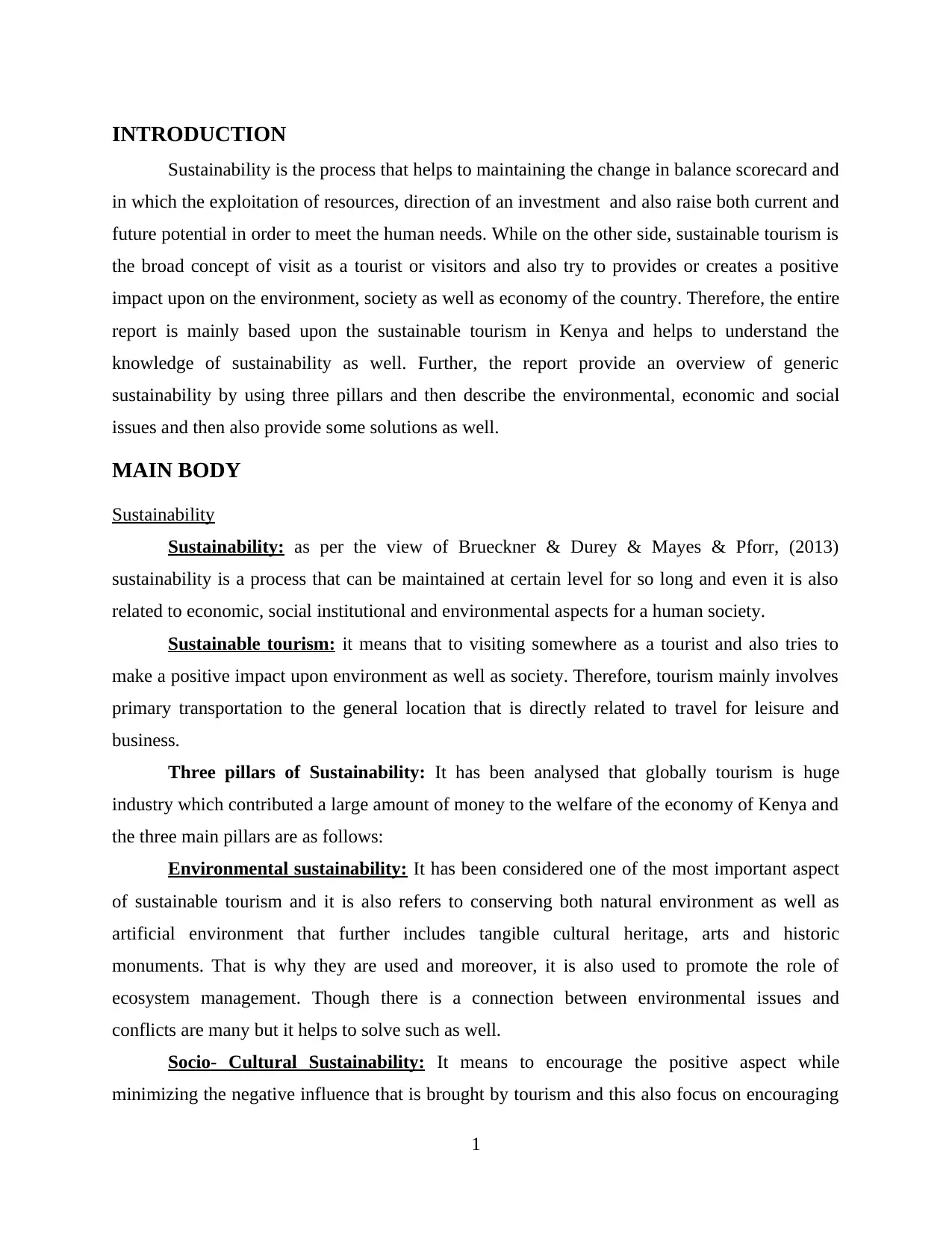
INTRODUCTION
Sustainability is the process that helps to maintaining the change in balance scorecard and
in which the exploitation of resources, direction of an investment and also raise both current and
future potential in order to meet the human needs. While on the other side, sustainable tourism is
the broad concept of visit as a tourist or visitors and also try to provides or creates a positive
impact upon on the environment, society as well as economy of the country. Therefore, the entire
report is mainly based upon the sustainable tourism in Kenya and helps to understand the
knowledge of sustainability as well. Further, the report provide an overview of generic
sustainability by using three pillars and then describe the environmental, economic and social
issues and then also provide some solutions as well.
MAIN BODY
Sustainability
Sustainability: as per the view of Brueckner & Durey & Mayes & Pforr, (2013)
sustainability is a process that can be maintained at certain level for so long and even it is also
related to economic, social institutional and environmental aspects for a human society.
Sustainable tourism: it means that to visiting somewhere as a tourist and also tries to
make a positive impact upon environment as well as society. Therefore, tourism mainly involves
primary transportation to the general location that is directly related to travel for leisure and
business.
Three pillars of Sustainability: It has been analysed that globally tourism is huge
industry which contributed a large amount of money to the welfare of the economy of Kenya and
the three main pillars are as follows:
Environmental sustainability: It has been considered one of the most important aspect
of sustainable tourism and it is also refers to conserving both natural environment as well as
artificial environment that further includes tangible cultural heritage, arts and historic
monuments. That is why they are used and moreover, it is also used to promote the role of
ecosystem management. Though there is a connection between environmental issues and
conflicts are many but it helps to solve such as well.
Socio- Cultural Sustainability: It means to encourage the positive aspect while
minimizing the negative influence that is brought by tourism and this also focus on encouraging
1
Sustainability is the process that helps to maintaining the change in balance scorecard and
in which the exploitation of resources, direction of an investment and also raise both current and
future potential in order to meet the human needs. While on the other side, sustainable tourism is
the broad concept of visit as a tourist or visitors and also try to provides or creates a positive
impact upon on the environment, society as well as economy of the country. Therefore, the entire
report is mainly based upon the sustainable tourism in Kenya and helps to understand the
knowledge of sustainability as well. Further, the report provide an overview of generic
sustainability by using three pillars and then describe the environmental, economic and social
issues and then also provide some solutions as well.
MAIN BODY
Sustainability
Sustainability: as per the view of Brueckner & Durey & Mayes & Pforr, (2013)
sustainability is a process that can be maintained at certain level for so long and even it is also
related to economic, social institutional and environmental aspects for a human society.
Sustainable tourism: it means that to visiting somewhere as a tourist and also tries to
make a positive impact upon environment as well as society. Therefore, tourism mainly involves
primary transportation to the general location that is directly related to travel for leisure and
business.
Three pillars of Sustainability: It has been analysed that globally tourism is huge
industry which contributed a large amount of money to the welfare of the economy of Kenya and
the three main pillars are as follows:
Environmental sustainability: It has been considered one of the most important aspect
of sustainable tourism and it is also refers to conserving both natural environment as well as
artificial environment that further includes tangible cultural heritage, arts and historic
monuments. That is why they are used and moreover, it is also used to promote the role of
ecosystem management. Though there is a connection between environmental issues and
conflicts are many but it helps to solve such as well.
Socio- Cultural Sustainability: It means to encourage the positive aspect while
minimizing the negative influence that is brought by tourism and this also focus on encouraging
1
Paraphrase This Document
Need a fresh take? Get an instant paraphrase of this document with our AI Paraphraser
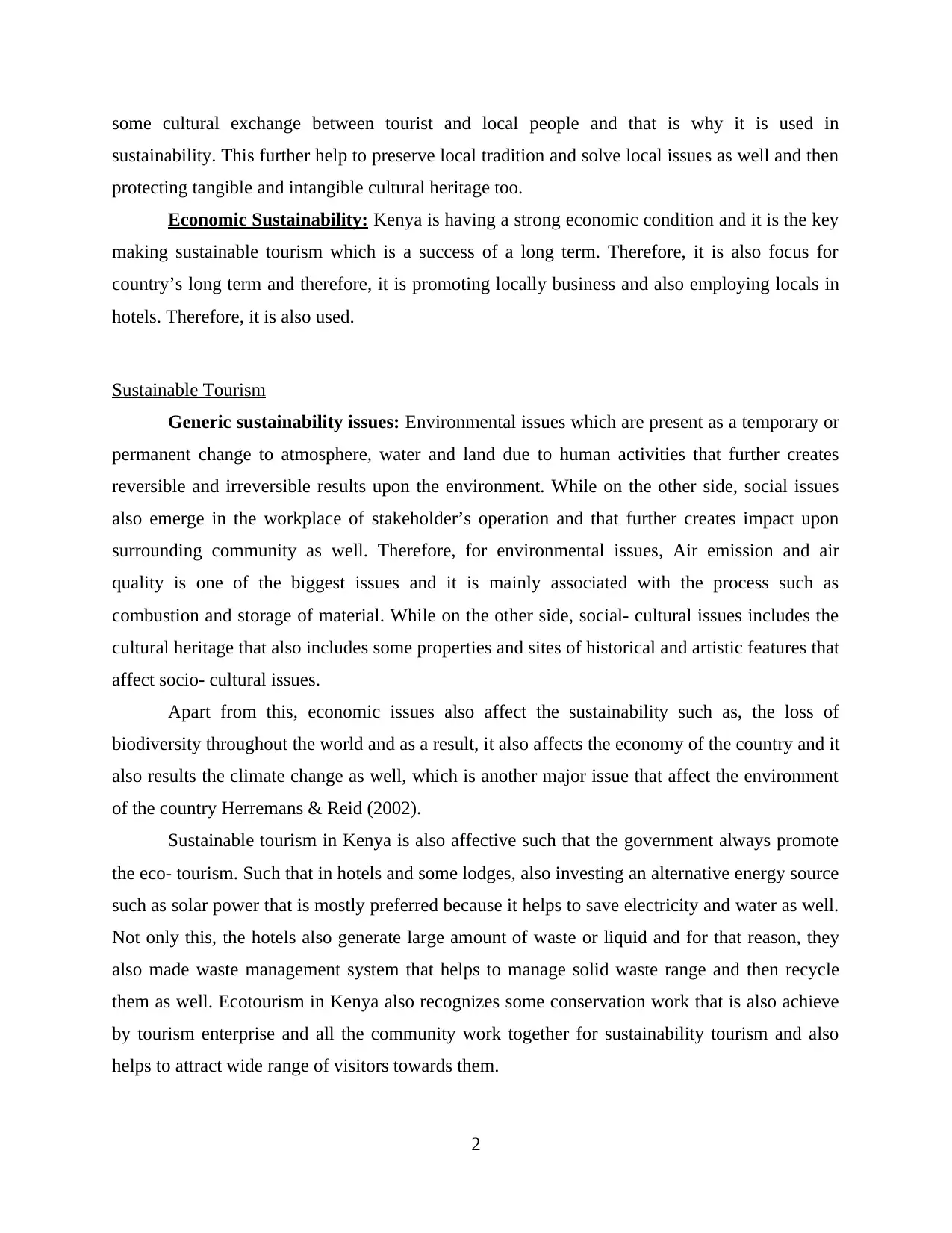
some cultural exchange between tourist and local people and that is why it is used in
sustainability. This further help to preserve local tradition and solve local issues as well and then
protecting tangible and intangible cultural heritage too.
Economic Sustainability: Kenya is having a strong economic condition and it is the key
making sustainable tourism which is a success of a long term. Therefore, it is also focus for
country’s long term and therefore, it is promoting locally business and also employing locals in
hotels. Therefore, it is also used.
Sustainable Tourism
Generic sustainability issues: Environmental issues which are present as a temporary or
permanent change to atmosphere, water and land due to human activities that further creates
reversible and irreversible results upon the environment. While on the other side, social issues
also emerge in the workplace of stakeholder’s operation and that further creates impact upon
surrounding community as well. Therefore, for environmental issues, Air emission and air
quality is one of the biggest issues and it is mainly associated with the process such as
combustion and storage of material. While on the other side, social- cultural issues includes the
cultural heritage that also includes some properties and sites of historical and artistic features that
affect socio- cultural issues.
Apart from this, economic issues also affect the sustainability such as, the loss of
biodiversity throughout the world and as a result, it also affects the economy of the country and it
also results the climate change as well, which is another major issue that affect the environment
of the country Herremans & Reid (2002).
Sustainable tourism in Kenya is also affective such that the government always promote
the eco- tourism. Such that in hotels and some lodges, also investing an alternative energy source
such as solar power that is mostly preferred because it helps to save electricity and water as well.
Not only this, the hotels also generate large amount of waste or liquid and for that reason, they
also made waste management system that helps to manage solid waste range and then recycle
them as well. Ecotourism in Kenya also recognizes some conservation work that is also achieve
by tourism enterprise and all the community work together for sustainability tourism and also
helps to attract wide range of visitors towards them.
2
sustainability. This further help to preserve local tradition and solve local issues as well and then
protecting tangible and intangible cultural heritage too.
Economic Sustainability: Kenya is having a strong economic condition and it is the key
making sustainable tourism which is a success of a long term. Therefore, it is also focus for
country’s long term and therefore, it is promoting locally business and also employing locals in
hotels. Therefore, it is also used.
Sustainable Tourism
Generic sustainability issues: Environmental issues which are present as a temporary or
permanent change to atmosphere, water and land due to human activities that further creates
reversible and irreversible results upon the environment. While on the other side, social issues
also emerge in the workplace of stakeholder’s operation and that further creates impact upon
surrounding community as well. Therefore, for environmental issues, Air emission and air
quality is one of the biggest issues and it is mainly associated with the process such as
combustion and storage of material. While on the other side, social- cultural issues includes the
cultural heritage that also includes some properties and sites of historical and artistic features that
affect socio- cultural issues.
Apart from this, economic issues also affect the sustainability such as, the loss of
biodiversity throughout the world and as a result, it also affects the economy of the country and it
also results the climate change as well, which is another major issue that affect the environment
of the country Herremans & Reid (2002).
Sustainable tourism in Kenya is also affective such that the government always promote
the eco- tourism. Such that in hotels and some lodges, also investing an alternative energy source
such as solar power that is mostly preferred because it helps to save electricity and water as well.
Not only this, the hotels also generate large amount of waste or liquid and for that reason, they
also made waste management system that helps to manage solid waste range and then recycle
them as well. Ecotourism in Kenya also recognizes some conservation work that is also achieve
by tourism enterprise and all the community work together for sustainability tourism and also
helps to attract wide range of visitors towards them.
2

Environmental Issue
In Kenya, the main environmental issue is related to Air and water pollution, that affects
the entire country and also affect the tourism in negative way as well. Apart from this, another
major issue which thee country faces is such that deforestation, soil erosion and water shortage
that combine affect the environment of the country (Environmental issues and solution for
sustainable tourism, 2018). Moreover, water shortage is another problem in Kenya and it also
create significant impact upon the environmental problems. As Kenya, is well known for having
a wide range of wildlife species but their habitat are also threaten by infringement of man. Not
only this, the country is suffering from excessive dumping and waste in rural as well as urban
areas such that almost all urban areas of Kenya have an inadequate rubbish collection and
disposal system that creates negative impact upon the visitors and they even did not prefer to
visit the place for next time.
Environmental Solutions
The government of Kenya introduce a project name A Green Economy Assessment
which mainly identify the key opportunities for a green economy transition ad further it also
includes the potential impact of increased green investment in the terms of economic growth and
also helps to reduce the poverty and causes environment improvement as well. Apart from this,
the government of Kenya also introduce Borgen project that also help to protect the environment
of the Kenya through Internet and creates awareness among the people so that the environment
issues are control.
Apart from this, to promote the ecological perspective of Kenya’s government, the nature
of Conservancy and Northern Rangelands trust also have the collaboration in order to develop
community conservancy and inn this project, more than 2 lac people are involved from 17
different ethnic tribes.
Economic issue
It is the another major issue for the government of Kenya because of the high
stakeholders expectations and there is a inadequate funding as well. That is why it directly
impact upon the economic situation of Kenya. As per the data, it has been analysed that Kenya’s
economy derives almost half of its GDP from the natural resources and more than half of the
people in a country is also reply on the agriculture activities. As the country’s main
environmental issue is also related to dumping and polluted air and water as well, thus as a
3
In Kenya, the main environmental issue is related to Air and water pollution, that affects
the entire country and also affect the tourism in negative way as well. Apart from this, another
major issue which thee country faces is such that deforestation, soil erosion and water shortage
that combine affect the environment of the country (Environmental issues and solution for
sustainable tourism, 2018). Moreover, water shortage is another problem in Kenya and it also
create significant impact upon the environmental problems. As Kenya, is well known for having
a wide range of wildlife species but their habitat are also threaten by infringement of man. Not
only this, the country is suffering from excessive dumping and waste in rural as well as urban
areas such that almost all urban areas of Kenya have an inadequate rubbish collection and
disposal system that creates negative impact upon the visitors and they even did not prefer to
visit the place for next time.
Environmental Solutions
The government of Kenya introduce a project name A Green Economy Assessment
which mainly identify the key opportunities for a green economy transition ad further it also
includes the potential impact of increased green investment in the terms of economic growth and
also helps to reduce the poverty and causes environment improvement as well. Apart from this,
the government of Kenya also introduce Borgen project that also help to protect the environment
of the Kenya through Internet and creates awareness among the people so that the environment
issues are control.
Apart from this, to promote the ecological perspective of Kenya’s government, the nature
of Conservancy and Northern Rangelands trust also have the collaboration in order to develop
community conservancy and inn this project, more than 2 lac people are involved from 17
different ethnic tribes.
Economic issue
It is the another major issue for the government of Kenya because of the high
stakeholders expectations and there is a inadequate funding as well. That is why it directly
impact upon the economic situation of Kenya. As per the data, it has been analysed that Kenya’s
economy derives almost half of its GDP from the natural resources and more than half of the
people in a country is also reply on the agriculture activities. As the country’s main
environmental issue is also related to dumping and polluted air and water as well, thus as a
3
⊘ This is a preview!⊘
Do you want full access?
Subscribe today to unlock all pages.

Trusted by 1+ million students worldwide

result, it directly affect the economy of the country and it is so because when the tourist are not
attracted towards a country, then there is no chances to enhance the economy of the country
Edgell (2016). As a result, the country’s economy also decline and it is possible only when the
government or travel agents are make ideas that helps to make economy sustainable.
Economic solution
In order to overcome the challenges, the government of Kenya also take initial steps such
that it intensified creates awareness programs related to economic sustainability and it also
introduce integrated development plans and public institutions with some strategic plans. Further
by reviewing the National Statistical system for SDGs and also enhancing multi- stakeholders’
participation during a process and also raise resource mobilization as well.
But on the other side, even after taking some steps by a government, there are still some
unsolved issues of economical tourism and to resolve these, the government of Kenya make
global LPG Partnership which further accelerates transition to LPG for cooking and also engage
the public and private sectors involved in the policy that helps to make positive impact upon
those issues. Moreover, the government also make global partnership for sustainable
development data which is for the multi- stakeholder’s network which is for more than data
champions that are further attaching the data revolution for the sustainable development Mihalic
(2016). Moreover, the Nansen Initiative is another major step whose main aim is to set in place
that measures the address and the needs of people and communities who are displaced from the
impact of some natural hazard and also creates an impact upon economy as well as environment
too.
Social Issue
Social issue also consider another major issue for sustainability of tourism such that
social and cultural issues generally refers to change in lives of people who living in some
destination communities and changes in arts and artefacts of a people as well. In Kenya, people
generally lives in rural area and as a result, the impact arises when tourism brings change in the
value of a system and behaviour that further threatening indigenous identity. Apart from this, the
tourist not only generate the positive impact as it can also serve as a supportive force for peace
and foster pride in some cultural tradition Budeanu and et.al., (2016). But in the other side, when
different types of tourist come to visit the place who belongs to different culture sometimes
creates a negative impact such that they sometimes did not understand the language and the
4
attracted towards a country, then there is no chances to enhance the economy of the country
Edgell (2016). As a result, the country’s economy also decline and it is possible only when the
government or travel agents are make ideas that helps to make economy sustainable.
Economic solution
In order to overcome the challenges, the government of Kenya also take initial steps such
that it intensified creates awareness programs related to economic sustainability and it also
introduce integrated development plans and public institutions with some strategic plans. Further
by reviewing the National Statistical system for SDGs and also enhancing multi- stakeholders’
participation during a process and also raise resource mobilization as well.
But on the other side, even after taking some steps by a government, there are still some
unsolved issues of economical tourism and to resolve these, the government of Kenya make
global LPG Partnership which further accelerates transition to LPG for cooking and also engage
the public and private sectors involved in the policy that helps to make positive impact upon
those issues. Moreover, the government also make global partnership for sustainable
development data which is for the multi- stakeholder’s network which is for more than data
champions that are further attaching the data revolution for the sustainable development Mihalic
(2016). Moreover, the Nansen Initiative is another major step whose main aim is to set in place
that measures the address and the needs of people and communities who are displaced from the
impact of some natural hazard and also creates an impact upon economy as well as environment
too.
Social Issue
Social issue also consider another major issue for sustainability of tourism such that
social and cultural issues generally refers to change in lives of people who living in some
destination communities and changes in arts and artefacts of a people as well. In Kenya, people
generally lives in rural area and as a result, the impact arises when tourism brings change in the
value of a system and behaviour that further threatening indigenous identity. Apart from this, the
tourist not only generate the positive impact as it can also serve as a supportive force for peace
and foster pride in some cultural tradition Budeanu and et.al., (2016). But in the other side, when
different types of tourist come to visit the place who belongs to different culture sometimes
creates a negative impact such that they sometimes did not understand the language and the
4
Paraphrase This Document
Need a fresh take? Get an instant paraphrase of this document with our AI Paraphraser
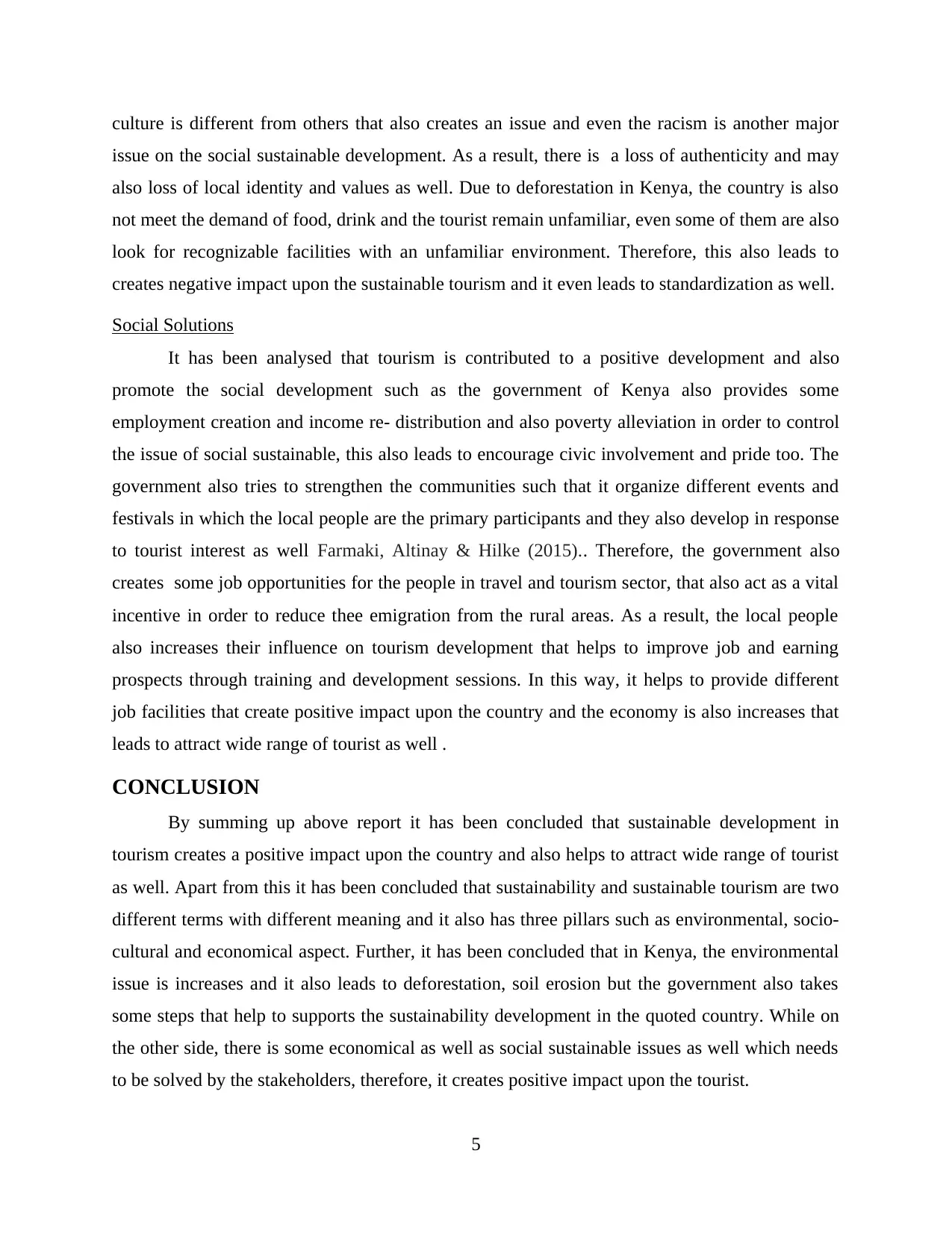
culture is different from others that also creates an issue and even the racism is another major
issue on the social sustainable development. As a result, there is a loss of authenticity and may
also loss of local identity and values as well. Due to deforestation in Kenya, the country is also
not meet the demand of food, drink and the tourist remain unfamiliar, even some of them are also
look for recognizable facilities with an unfamiliar environment. Therefore, this also leads to
creates negative impact upon the sustainable tourism and it even leads to standardization as well.
Social Solutions
It has been analysed that tourism is contributed to a positive development and also
promote the social development such as the government of Kenya also provides some
employment creation and income re- distribution and also poverty alleviation in order to control
the issue of social sustainable, this also leads to encourage civic involvement and pride too. The
government also tries to strengthen the communities such that it organize different events and
festivals in which the local people are the primary participants and they also develop in response
to tourist interest as well Farmaki, Altinay & Hilke (2015).. Therefore, the government also
creates some job opportunities for the people in travel and tourism sector, that also act as a vital
incentive in order to reduce thee emigration from the rural areas. As a result, the local people
also increases their influence on tourism development that helps to improve job and earning
prospects through training and development sessions. In this way, it helps to provide different
job facilities that create positive impact upon the country and the economy is also increases that
leads to attract wide range of tourist as well .
CONCLUSION
By summing up above report it has been concluded that sustainable development in
tourism creates a positive impact upon the country and also helps to attract wide range of tourist
as well. Apart from this it has been concluded that sustainability and sustainable tourism are two
different terms with different meaning and it also has three pillars such as environmental, socio-
cultural and economical aspect. Further, it has been concluded that in Kenya, the environmental
issue is increases and it also leads to deforestation, soil erosion but the government also takes
some steps that help to supports the sustainability development in the quoted country. While on
the other side, there is some economical as well as social sustainable issues as well which needs
to be solved by the stakeholders, therefore, it creates positive impact upon the tourist.
5
issue on the social sustainable development. As a result, there is a loss of authenticity and may
also loss of local identity and values as well. Due to deforestation in Kenya, the country is also
not meet the demand of food, drink and the tourist remain unfamiliar, even some of them are also
look for recognizable facilities with an unfamiliar environment. Therefore, this also leads to
creates negative impact upon the sustainable tourism and it even leads to standardization as well.
Social Solutions
It has been analysed that tourism is contributed to a positive development and also
promote the social development such as the government of Kenya also provides some
employment creation and income re- distribution and also poverty alleviation in order to control
the issue of social sustainable, this also leads to encourage civic involvement and pride too. The
government also tries to strengthen the communities such that it organize different events and
festivals in which the local people are the primary participants and they also develop in response
to tourist interest as well Farmaki, Altinay & Hilke (2015).. Therefore, the government also
creates some job opportunities for the people in travel and tourism sector, that also act as a vital
incentive in order to reduce thee emigration from the rural areas. As a result, the local people
also increases their influence on tourism development that helps to improve job and earning
prospects through training and development sessions. In this way, it helps to provide different
job facilities that create positive impact upon the country and the economy is also increases that
leads to attract wide range of tourist as well .
CONCLUSION
By summing up above report it has been concluded that sustainable development in
tourism creates a positive impact upon the country and also helps to attract wide range of tourist
as well. Apart from this it has been concluded that sustainability and sustainable tourism are two
different terms with different meaning and it also has three pillars such as environmental, socio-
cultural and economical aspect. Further, it has been concluded that in Kenya, the environmental
issue is increases and it also leads to deforestation, soil erosion but the government also takes
some steps that help to supports the sustainability development in the quoted country. While on
the other side, there is some economical as well as social sustainable issues as well which needs
to be solved by the stakeholders, therefore, it creates positive impact upon the tourist.
5
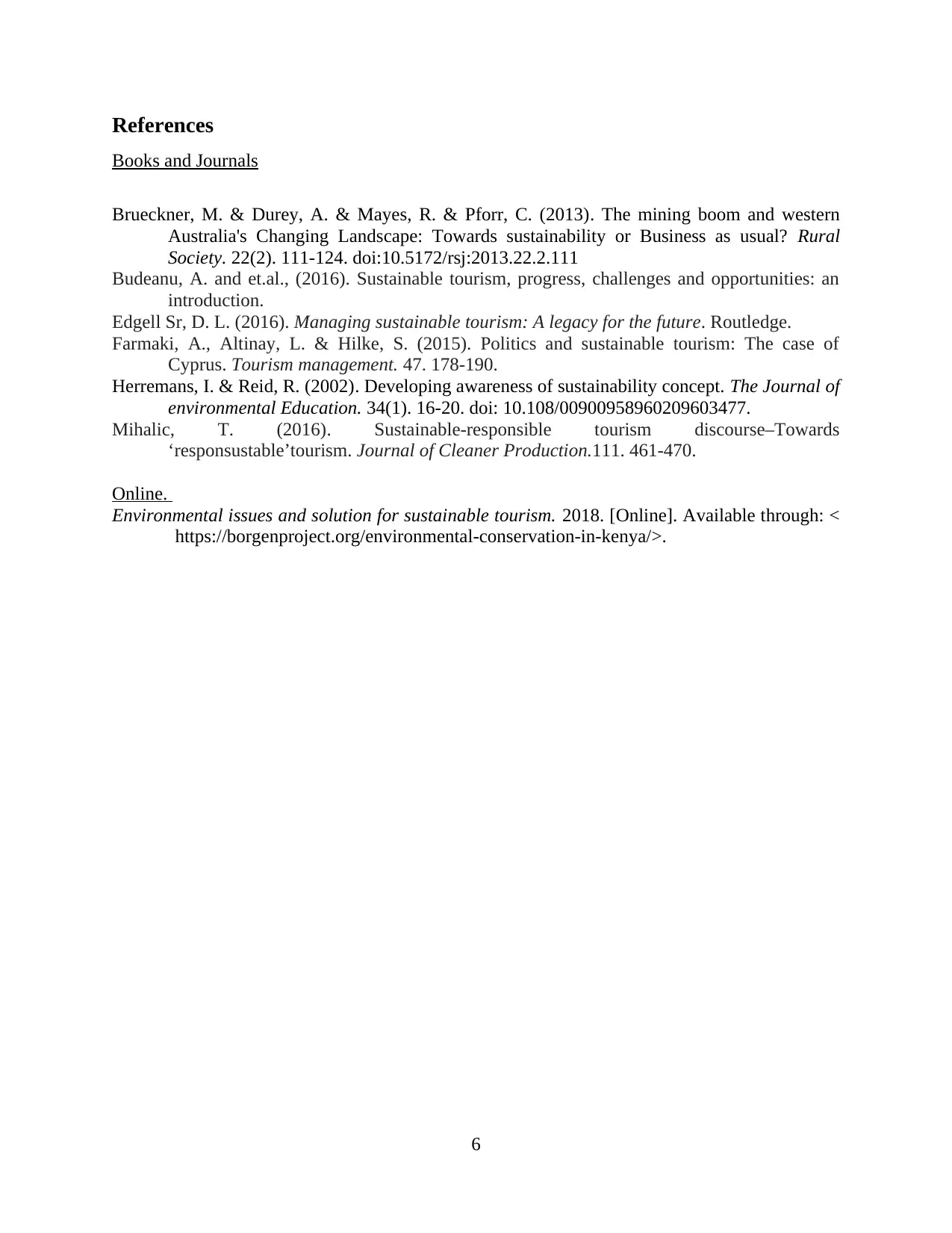
References
Books and Journals
Brueckner, M. & Durey, A. & Mayes, R. & Pforr, C. (2013). The mining boom and western
Australia's Changing Landscape: Towards sustainability or Business as usual? Rural
Society. 22(2). 111-124. doi:10.5172/rsj:2013.22.2.111
Budeanu, A. and et.al., (2016). Sustainable tourism, progress, challenges and opportunities: an
introduction.
Edgell Sr, D. L. (2016). Managing sustainable tourism: A legacy for the future. Routledge.
Farmaki, A., Altinay, L. & Hilke, S. (2015). Politics and sustainable tourism: The case of
Cyprus. Tourism management. 47. 178-190.
Herremans, I. & Reid, R. (2002). Developing awareness of sustainability concept. The Journal of
environmental Education. 34(1). 16-20. doi: 10.108/00900958960209603477.
Mihalic, T. (2016). Sustainable-responsible tourism discourse–Towards
‘responsustable’tourism. Journal of Cleaner Production.111. 461-470.
Online.
Environmental issues and solution for sustainable tourism. 2018. [Online]. Available through: <
https://borgenproject.org/environmental-conservation-in-kenya/>.
6
Books and Journals
Brueckner, M. & Durey, A. & Mayes, R. & Pforr, C. (2013). The mining boom and western
Australia's Changing Landscape: Towards sustainability or Business as usual? Rural
Society. 22(2). 111-124. doi:10.5172/rsj:2013.22.2.111
Budeanu, A. and et.al., (2016). Sustainable tourism, progress, challenges and opportunities: an
introduction.
Edgell Sr, D. L. (2016). Managing sustainable tourism: A legacy for the future. Routledge.
Farmaki, A., Altinay, L. & Hilke, S. (2015). Politics and sustainable tourism: The case of
Cyprus. Tourism management. 47. 178-190.
Herremans, I. & Reid, R. (2002). Developing awareness of sustainability concept. The Journal of
environmental Education. 34(1). 16-20. doi: 10.108/00900958960209603477.
Mihalic, T. (2016). Sustainable-responsible tourism discourse–Towards
‘responsustable’tourism. Journal of Cleaner Production.111. 461-470.
Online.
Environmental issues and solution for sustainable tourism. 2018. [Online]. Available through: <
https://borgenproject.org/environmental-conservation-in-kenya/>.
6
⊘ This is a preview!⊘
Do you want full access?
Subscribe today to unlock all pages.

Trusted by 1+ million students worldwide
1 out of 9
Related Documents
Your All-in-One AI-Powered Toolkit for Academic Success.
+13062052269
info@desklib.com
Available 24*7 on WhatsApp / Email
![[object Object]](/_next/static/media/star-bottom.7253800d.svg)
Unlock your academic potential
Copyright © 2020–2025 A2Z Services. All Rights Reserved. Developed and managed by ZUCOL.

